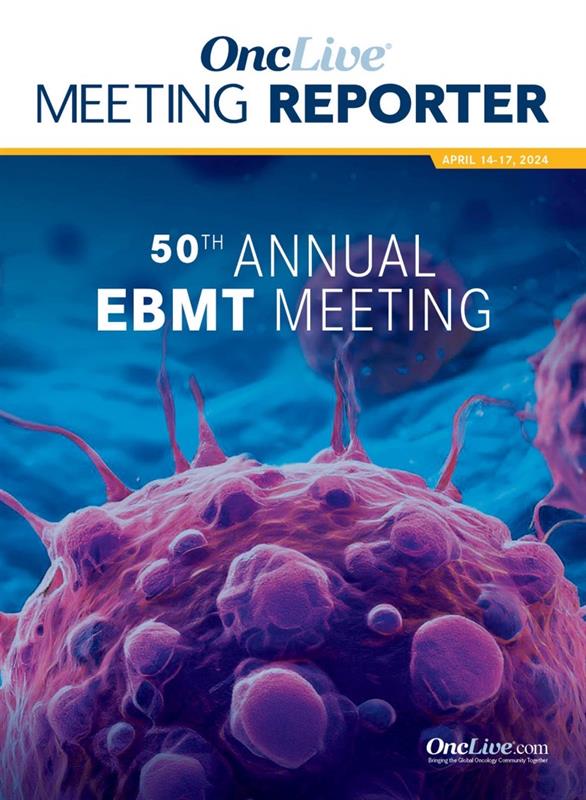News
Article
Supplements and Featured Publications
Prophylactic Itacitinib May Safely Mitigate CRS Following Axi-Cel Administration in Lymphoma
Author(s):
Key Takeaways
- Itacitinib significantly reduced the incidence and severity of CRS and ICANS in lymphoma patients treated with axi-cel.
- The itacitinib arm showed lower rates of grade 2 or higher CRS and ICANS compared to placebo.
Itacitinib prophylaxis showed signals for reducing CRS and ICANS following treatment with axicabtagene ciloleucel in patients with B-cell lymphoma.
Richard Maziarz, MD

Prophylactic administration of a twice-daily, 200-mg dose of itacitinib was well tolerated and decreased the incidence and severity of cytokine release syndrome (CRS) and immune effector cell–associated neurotoxicity syndrome (ICANS) in patients with lymphoma who received axicabtagene ciloleucel (Yescarta; axi-cel), according to data from a phase 2 trial (NCT04071366) presented during the 50th Annual EBMT Meeting.1
Assessment of CRS incidence by day 14 showed a significantly lower rate of grade 2 or higher CRS in the itacitinib arm (n = 23) compared with the placebo arm (n = 23), and the rates of grade 2 CRS were 17.4% and 56.5%, respectively (95% CI, 0.14-0.65; P = .003). The overall incidence of CRS was 65.2% in the itacitinib arm vs 87.0% with placebo. Tocilizumab (Actemra) was administered for CRS in 65.2% of patients in the placebo arm vs 17.4% of patients in the itacitinib arm, and an additional 13.0% of patients in the placebo arm also received dexamethasone. In the itacitinib arm, the time to CRS onset was 2 days (range, 0-8), and the median duration of grade 2 or higher CRS was 2 days (range, 1-8). In the placebo arm, these respective ranges were 3 days (range, 0-9) and 2 days (range, 1-5).
At day 28, the estimated CRS-free survival was 70% (95% CI, 47%-84%) in patients treated with itacitinib and 26% (95% CI, 11%-45%) in those who received placebo. The incidence of grade 2 or higher CRS was 17.4% with itacitinib and 47.8% with placebo. Moreover, the rate of patients who received tocilizumab for CRS was higher in the itacitinib arm (8.7%) vs the placebo arm (26.1%). No patients required corticosteroids for CRS in either arm, and 1 patient died prior to day 28 in the itacitinib arm.
“Prophylactic itacitinib does appear to have promising activity for reducing the incidence of CRS, but also [shows] a signal [for] reducing ICANS in patients receiving axi-cel,” presenting author Richard Maziarz, MD, medical director of the Blood & Marrow Transplant & Cellular Therapy Program at Oregon Health and Science University in Portland, stated in an oral presentation of the data. “Biomarker analyses also demonstrate [itacitinib’s] potential benefit in not inhibiting CAR T-cell expansion.”
Further evaluation of ICANS events revealed that 3 patients developed ICANS by day 28 following itacitinib treatment vs 8 patients who received placebo. The overall incidence of ICANS was 13.0% (95% CI, 2.8%-33.6%) in the itacitinib arm vs 34.8% (95% CI, 16.4%-57.3%) with placebo. Grade 1, 2, and 3 ICANS events were experienced by 4.3% of patients each in the itacitinib arm; these rates were 13.0%, 8.7%, and 13.0% in the placebo arm.
Dexamethasone treatment for ICANS was administered in 4.3% of patients in the placebo arm vs 30.4% of patients in the itacitinib arm, with another 4.3% of patients in the placebo arm being treated with siltuximab (Sylvant). In the itacitinib arm, the time to ICANS onset was 5 days (range, 4-9), and the median duration of any-grade ICANS was 2 days (range, 2-11). In the placebo arm, these respective ranges were 6.5 days (range, 2-11) and 3.5 days (range, 2-13).
However, there was a higher incidence of grade 3/4 neutropenia and thrombocytopenia that was not resolved at day 28 with itacitinib vs placebo, and the rates of severe infection were similar between the 2 arms.
CRS and ICANs events are frequently observed after treatment with immune effector cell therapy. These adverse effects (AEs) are characterized by the release of inflammatory cytokines, which are activated through the downstream JAK signaling pathway.
Itacitinib, a potent and selective JAK1 inhibitor known for its extensive anti-inflammatory effects in various preclinical disease models, has also shown promise in reducing cytokine expression induced by CAR T-cell therapy.
“We all know that we can manage CRS and ICANs, but it is a real demand on health resource utilization,” Maziarz explained during the presentation. “If we can control these [toxicities], it could positively impact the further delivery of CAR T-cell therapy.
Accordingly, a randomized, double-blind, placebo-controlled phase 2 study was conducted to evaluate whether a twice-daily, 200-mg dose of itacitinib could mitigate CRS in patients with lymphoma who received axi-cel. The study consisted of 2 parts respectively assessing a daily and twice-daily 200-mg dose of itacitinib. Previously reported data from part 1 of this phase 2 study also showed that administering 200 mg of prophylactic itacitinib per day was tolerable and associated with signals of activity for CRS prevention in patients treated with commercial immune effector cell therapy.
“It is important to recognize that patients [in part 1] were not receiving any intervention for grade 1 CRS,” Maziarz added. “We saw a positive signal, and it was decided that we would proceed to the second part of the study.”
Part 2 of the study included patients who were at least 18 years of age and were eligible for treatment with axi-cel. Patients were also required to have an ECOG performance status of 0 or 1. Patients were randomly assigned 1:1 to receive either the previously specified dose of itacitinib or twice-daily placebo on days –3 to 26 of treatment with axi-cel. Notably, tocilizumab could be administered for grade 1 CRS if no improvements were observed within 72 hours. Hematologic disease assessments were conducted at day 90. Maziarz noted that patients underwent continuous temperature monitoring to avoid missing fevers at home.
The study’s primary end point was the incidence of grade 2 or higher CRS by day 14 per ASTCT consensus grading. Secondary end points included the incidence of ICANS by day 28, CRS and ICANS duration, safety, pharmacokinetics, biomarkers, and overall response rate achieved with immune effector cell therapy.
Forty-two of the 47 patients enrolled onto part 2 of the trial completed treatment, comprising 21 patients in each arm. Reasons for treatment discontinuation included AEs (4.3% in the itacitinib arm; 8.3% in the placebo arm), disease progression (4.3%; 0.0%), and physician’s choice to withdraw (0.0%; 4.2%).
Baseline characteristics were similar across treatment groups. All patients had diffuse large B-cell lymphoma (LBCL) with the exception of 1 patient with transformed follicular lymphoma in the itacitinib arm.
The median age of patients was 66 years (range, 29-80) in the itacitinib arm and 64 years (range, 31-79) in the placebo arm. Over half of patients (56.5%) in the itacitinib arm were at least 65 years old vs 41.7% of those in the placebo arm. Most patients across both arms were men (itacitinib, 65.2%; placebo, 70.8%), White (91.3%; 87.5%), had an international prognostic index score of 3 or higher (56.5%; 58.3%), and had Ann Arbor stage III/IV disease (56.5%; 50.0%). Germinal center B-cell subtype was present in 52.2% and 37.5% of patients in the itacitinib and placebo arms, respectively. The median number of prior regimens received in the itacitinib arm was 2 (range, 1-6) vs 1.5 (range, 1-4) in the placebo arm. Prior hematopoietic stem cell transplant had been administered to 21.7% and 16.7% of patients in the itacitinib and placebo arms, respectively. No patients in the itacitinib arm had a history of primary refractory disease vs 16.7% of those in the placebo arm. Lastly, the median lactate dehydrogenase level in the itacitinib arm was 200.0 U/L (range, 117-863) vs 208.5 U/L (range, 136-905) in the placebo arm.
Regarding safety, 8.7% of patients in the itacitinib arm experienced grade 3 or higher infections vs 12.5% of those who received placebo. Observed grade 3 or higher infections included pneumonia (itacitinib, 0.0%; placebo, 4.2%), sepsis (0.0%; 8.3%), urinary tract infection (8.7%; 4.2%), and bacterial infection (0.0%; 4.2%)
At day 28, persistent grade 4 neutropenia and grade 4 thrombocytopenia were respectively reported in 13.6% and 18.2% of patients treated with itacitinib. No patients experienced either grade 4 AE with placebo. Other grade 3 cytopenias observed at day 28 included neutropenia (itacitinib, 18.2%; placebo, 13.6%), thrombocytopenia (18.2%; 18.2%), and anemia (9.1%; 4.5%). One platelet transfusion was administered to 2 patients in the itacitinib arm and 1 patient in the placebo arm after day 28. No fatal AEs were observed.
Subsequent evaluation of responses with axi-cel showed that the best overall response rate (ORR) was 78.3% (95% CI, 56.3%-92.5%) in the itacitinib arm and 73.9% (95% CI, 51.6%-89.8%) in the placebo arm. In the itacitinib arm, the 3- and 6-month ORRs were 60.9% (95% CI, 38.5%-80.3%) and 39.1% (95% CI, 19.7%-61.5%), respectively; corresponding rates in the placebo arm were 47.8% (95% CI, 26.8%- 69.4%) and 26.1% (95% CI, 10.2%-48.4%), respectively.
“The best ORR at 3 and 6 months was actually, [although] these are small numbers, numerically higher in the itacitinib arm,” Maziarz expanded. “This signals [that itacitinib treatment] does not impair the function of the CAR T-cell therapy.”
Additionally, CAR T-cell infusion was found to produce a transient increase in the systemic cytokines tumor necrosis factor α (TNF-α; adjusted P < .001) and interleukin-6 (IL-6; adjusted P < .05) with the onset of CRS and ICANS.
Maziarz explained that “one of the questions that we also raised was: ‘Can we examine the actual impact [of itacitinib] sequentially on cytokines?’ In part 2, characteristic cytokines of TNF-α and IL-6 were higher in the patients who received placebo vs itacitinib, meeting what we would have anticipated.”
Analysis of CAR T-cell expansion over time also showed that expansion reached its peak 7 to 14 days after axi-cel infusion. Notably, no significant difference in CAR T-cell expansion was observed in patients with LBCL who received axi-cel infusion followed by itacitinib vs placebo.
Maziarz concludes by stating that further investigations of itacitinib’s effect on CAR T-cell expansion and function are ongoing.
Disclosures: Dr Maziarz reports serving as an advisor or consultant for Artiva, CRISPR Therapeutics, Incyte Corporation, Allovir, and Novartis; providing research support for Bristol-Myers Squibb, Orca Biotech, and Novartis; and participating in data and safety monitoring boards for Novartis, Athersys, Vor Pharmaceuticals, and Century Therapeutics.
Reference
Frigault M, Maziarz R, Park J, et al. Itacitinib for the prevention of immune effector cell therapy-associated cytokine release syndrome: results from the phase 2 Incb 39110-211 placebo-controlled randomized cohort. Presented at: EBMT 50th Annual Meeting; April 14-17, 2024. Glasgow, Scotland. Abstract OS6-04.








%20u.jpg?fit=crop&auto=format)

%20(2)%201-Recovered-Recovered-Recovered-Recovered-Recovered-Recovered-Recovered-Recovered-Recovered-Recovered-Recovered-Recovered-Recovered-Recovered-Recovered-Recovered-Recovered-Recovered-Recovered.jpg?fit=crop&auto=format)